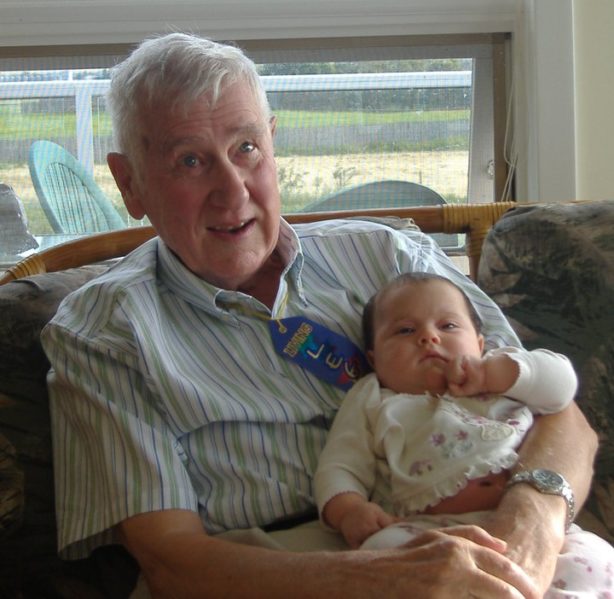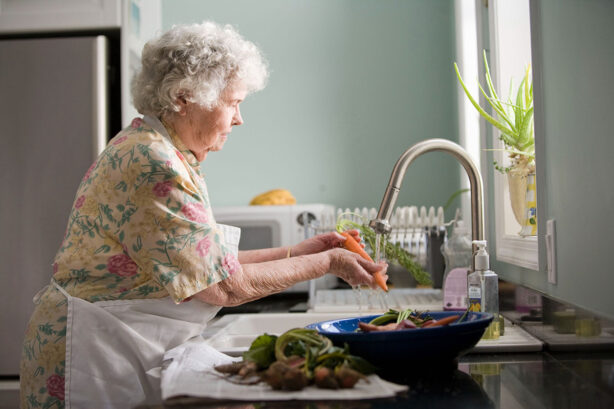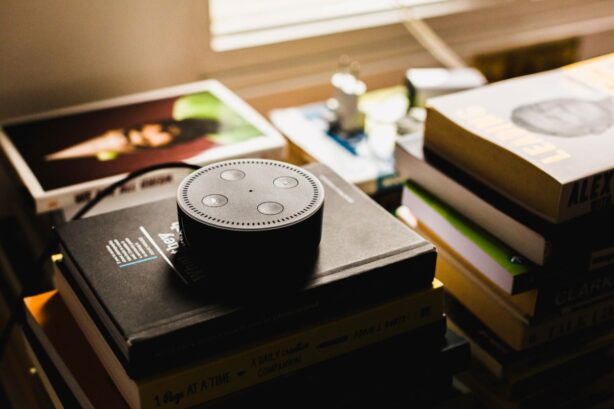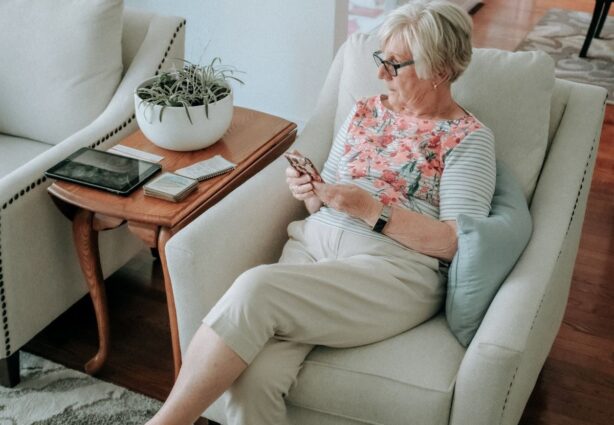It’s never easy watching our loved ones get older. Seeing them begin to struggle with tasks that were previously easy can take an emotional toll.

But, in our modern world, there are many ways that adults can create a space that promotes comfort, safety, and independence for aging loved ones.
If you’re assisting an elderly parent or grandparent, and are wondering what home improvements might help lighten the load of your caregiver checklist, consider these 12 ways to create a safe home for elderly loved ones:
12 Tips for Creating a Safe Home for Elderly Parents
1. Ensure Adequate Space for Maneuvering
Create an environment that allows for easy maneuverability, particularly if your elderly parents use walkers or wheelchairs.
Arrange furniture in a way that allows for unobstructed pathways, providing enough space for your parents to navigate comfortably.
Put special thought into areas where common activities occur. For example, ensure there is enough room around dining tables or workspaces for them to easily access and use these areas.
2. Rearrange Furniture to Minimize Tripping Hazards
Tripping hazards can pose significant risks to the safety of your elderly parents. Carefully evaluate the placement of furniture, looking for potential obstacles in their paths.
Rearrange or remove any items that could become trip hazards, such as loose rugs, cords, or low-lying furniture.
Creating clear pathways not only reduces the risk of accidents but also allows for smoother navigation throughout the living space.
You may also want to use visual cues like contrasting colors or floor markings to highlight pathways, especially in areas with poor lighting.
3. Install Lever-Style or Touch-Sensitive Faucets
Traditional faucet handles can be challenging for individuals with limited dexterity or hand strength. Installing lever-style or touch-sensitive faucets can improve ease-of-use and independence in the kitchen.
Lever-style faucets allow for effortless control of water flow and temperature with a simple up-and-down or side-to-side motion.
Touch-sensitive faucets, which activate with a gentle touch, eliminate the need for gripping or turning knobs.
These adaptations make tasks such as washing dishes or filling pots easier and more accessible for your parents.

4. Enhance Overall Lighting
Proper lighting helps reduce the risk of falls and accidents by providing better visibility and enhancing spatial awareness.
Evaluate the existing lighting in their home and consider making improvements where necessary.
Ensure that all spaces are well-lit, paying special attention to areas such as entryways, hallways, and frequently used spaces. Replace dim or outdated light fixtures with brighter and more energy-efficient options.
If necessary, consider installing overhead lighting or ceiling-mounted fixtures that distribute light evenly throughout the room.
5. Add Extra Lighting in Specific Areas
In addition to overall lighting, incorporating task lighting in specific areas can improve visibility and enhance functionality.
Task lighting focuses light on particular tasks or activities, reducing eyestrain and making it easier for your parents to engage in their favorite hobbies or tasks.
Start by adding desk lamps or adjustable reading lights in designated reading nooks or workspaces.
Installing under-cabinet lighting in the kitchen to illuminate countertops is also handy, make food preparation safer and more enjoyable.
6. Consider Adding Smart Home Devices
Smart home devices are designed to make life easier and more enjoyable for people of all ages.
They can assist with setting reminders, answering questions, playing music, and even controlling other smart devices in the home.
Voice commands make these devices accessible and user-friendly for individuals with limited mobility or dexterity.
A smart home assistant can also be used to set reminders for appointments, taking medication, and other important events.
Emergency alert systems are another valuable tool for ensuring the safety of your parents.
These systems typically include wearable or wall-mounted devices that can be activated in case of an emergency, immediately connecting them to a call center or emergency services.

7. Use Contrasting Colors or Tape on Stairs and Steps
Stairs and steps can be particularly challenging for older adults, as changes in depth perception can increase the risk of falls.
Enhance the visibility and safety of staircases by using contrasting colors or applying tape on the edge of each step. This visual cue can help better distinguish the different levels, reducing the likelihood of missteps.
If using tape, ensure it is securely applied and easy to clean for maintenance purposes. It’s a simple, yet effective way to provide added confidence when navigating stairs.
8. Install Grab Bars in Bathrooms
Place grab bars near the toilet to provide stability and support when sitting down or standing up. Similarly, install grab bars in the shower or bathtub to assist with balance and prevent slips.
Choose grab bars that are specifically designed for bathroom use and can withstand weight and moisture. Ensure they are securely anchored to the wall for maximum stability.
Grab bars offer elderly loved ones a reliable means of supporting themselves, promoting independence and reducing the risk of accidents.
9. Add a Raised Toilet Seat or Commode Chair
For individuals with mobility issues or difficulties getting on and off the toilet, a raised toilet seat or commode chair can be immensely beneficial.
These devices increase the height of the toilet seat, making it easier for your loved one to sit and stand without straining their joints or muscles.
Raised toilet seats come in various heights and can be easily installed on top of the existing toilet. Commode chairs, on the other hand, are standalone portable chairs with a hole in the seat and a container beneath for waste collection.
Consider the needs and preferences of your parent or grandparent to determine which option would best suit their requirements.

10. Install Shelves and Cabinets at Reachable Heights
When it comes to storage, installing shelves and cabinets at reachable heights for your elderly parents can be a great improvement to quality of life.
By placing commonly used items within easy reach, you eliminate the need for excessive bending, stretching, or climbing, reducing the risk of accidents or strain.
Adjust existing shelves, or install new ones to accommodate your parents’ height and mobility. Place frequently used items on the most easy-to-access areas.
Use higher shelves for items that are less frequently needed, or for items that require assistance from caregivers.
11. Invest In Adjustable or Motorized Furniture
Adjustable or motorized furniture can greatly enhance convenience and independence for your elderly parents.
Active elderly adults may enjoy using adjustable height tables or desks that can accommodate different seating positions.
Electric recliners and adjustable bed bases can provide added comfort and convenience.
If your loved one is starting to develop more severe mobility issues, motorized lift chairs and beds that aid in transitioning from standing to sitting to laying down can be useful.
When exploring adjustable or motorized furniture options, ensure that the controls are user-friendly and easy to control.
12. Choose Slip-Resistant Flooring
Opt for slip-resistant flooring choices, such as non-slip tiles or low-pile carpeting, to minimize the risk of falls and accidents.
These types of flooring provide better traction and reduce the chances of slipping, especially in high-traffic areas or places prone to moisture.
Non-slip tiles, which often have textured surfaces, are an excellent choice for entryways, bathrooms, and kitchens. They offer enhanced grip, even when wet.
If your parents prefer carpeting, choose low-pile carpets that are easier to move across smoothly.

Creating a safe home for elderly parents or grandparents may require a bit of planning, rearranging, and upgrading different rooms.
But, the effort will be well worth it when you’ve created a space that promotes safety, accessibility, and independence.
Make sure to actively involve your loved ones in the decision-making process, so that you prioritize the upgrades that will most improve their day-to-day lives. Remember, nobody’s needs will be exactly alike!
By keeping your own parent’s specific challenges and requirements in mind, you’ll be able to create a safe home for your elderly loved ones that’s comfortable and enjoyable for them to spend time in.

This is so great! We are having my mother move in with us in October. It will be a big adjustment but i wouldn’t want her anywhere else. I want to make sure everything is ready for her. Her room is on the main floor to avoid stairs and I also want to keep the air quality clean so I scheduled a carpet cleaning in September too. Anyway, thank you for the tips.